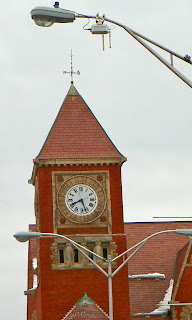
Wi-Fi emitters dangle from a streetlight in Amherst town center
Work has commenced replacing the downtown WiFi emitters on our still somewhat rare free public Internet access, a joint project with two UMass professors six years ago who were doing a doomsday project for the Department of Defense.
All 14 or the original emitters will be replaced and another 8 access points will be added, bringing the total to 22. According to Information Technology Director Kris Pacunas the refreshed grid will be "faster, more reliable and will be able to handle many more simultaneous users."
Since the emitters are being replaced one at a time, at no point will the entire system be down and the work, costing $20,000, should be completed by mid-October.
The town also appropriated $85,000 to outfit Town Hall with a generator to allow the seat of government to become an Emergency Operation Center in the event of a major incident like the freak snowstorm last October 29, which knocked out all modes of communication including the public WiFi.

A frivolous waste of money on both ends. The students use the public wi-fi the most, and I'd rather see the university spend money on itself. Not to mention the local businesses provide a number of hot-spots themselves, so the town wasn't missing out anyways.
ReplyDeleteThe money originally came from a Department of Defense grant so no University money was spent on the original installation.
ReplyDeleteI see plenty of regular townfolk using the system in town center when I'm there using it myself.
It was managed through the university, and the DoD should buy body armor rather than such superfluous things, once again ,provided by businesses with faster service.
ReplyDeleteYeah, or those $600 toilet seats and $400 claw hammers.
ReplyDeleteThat doesn't excuse the waste of taxpayer money on this project. Those are just as poor expenditures.
ReplyDeleteLK,
ReplyDeleteThanks for engaging "Radio Nowhere" - he doesn't have the whole picture (or - as his name suggests - has no picture at all ;-) of what this wireless service also provides; and he is clueless from whence it came. In fact, it might be a nice change of pace for your blog to do a more in depth report (interview, Pacunas and "the two professors" involved, e.g.) and educate folks about this.
Btw, it wasn't really a "doomsday project" as you quip - it was about mobile communication at high bandwidth with roving "servers" and the like - that's pretty useful for all sorts of things, and represents a natural evolution of the internet, which DARPA also funded from the outset.
Your reporting is getting better and better (even if we don't always agree on the politics ;-),
-YF